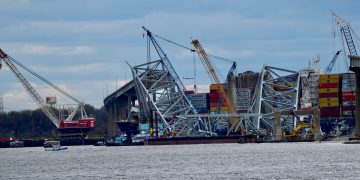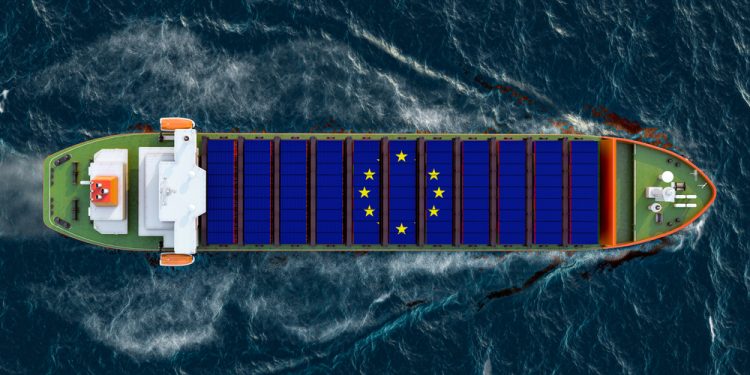During the 2024 GREEN4SEA Athens Forum, Andreas Philippou, CEO of Dromon Bureau of Shipping, delivered a presentation focused on the EU ETS (European Union Emissions Trading System) and its impact on the EU MRV (Monitoring, Reporting, and Verification) framework.
What is the EU ETS?
The European Union’s Emissions Trading System (ETS) was established in 2005 and is considered the cornerstone of EU’s climate policy. It is the EU’s flagship tool to target climate change and meet its net zero goals, aiming to reduce greenhouse gas (GHG) emissions by at least 62% by 2030 compared with 2005 levels.
In practice, the EU ETS works as a ‘cap-and-trade’ mechanism where a limit is placed on the total greenhouse gas emissions that participants are allowed to emit. The cap is reduced annually in line with the EU’s climate target to ensure that emissions decrease over time.
When will the extension of the EU ETS to shipping come into effect?
Emissions from maritime transport were brough into the EU ETS on 1 January 2024. Currently, the scheme only applies to cargo and passenger vessels of over 5,000 GT. From 2027, offshore vessels of the same size will be included. An important characteristic of the system is that it is based on flag neutrality, meaning it applies to all vessels regardless of flag. It covers 100% of emissions from voyages between and within the EU and 50% of emissions from voyages starting or ending outside the EU.
A phase-in period for the surrendering of allowances has been introduced, beginning in 2024 with the obligation to surrender 40% of a vessel’s verified emissions, increasing to 70% in 2025 and 100% from 2026 onwards.
Currently, the scheme covers all carbon dioxide (CO2) emissions and will expand to include methane (CH4) and nitrous oxide (N2O) emissions from 2026. The rules apply to all EU Members States, including the EEA countries Iceland and Norway.
Applicability
The table reflects a summary of the applicability of both the EU ETS and EU MRV based on vessel type and size, greenhouse gas emissions and phase-in period versus applicable dates. Cargo and passenger vessels of over 5,000 GT are already covered by both regulations, while offshore vessels of over 5,000 GT will be included in the EU MRV from 2025 and the EU ETS from 2027. There are also different applicability dates for greenhouse gases as well as a phase-in period for the emissions to be surrendered as per EU ETS Directive (40% in 2024, 70% in 2025 and 100% from 2026 onwards).
Responsibility of compliance for the EU ETS
The responsibility of compliance for EU ETS rests on the ‘shipping company’. By default, the shipowner is the entity responsible for compliance, though the regulation allows for the possibility of the ISM company (DOC Holder) to assume the responsibility on behalf of the shipowner with the preparation of a mandate agreement outlining the delegation of this responsibility from the shipowner to the ISM company, duly signed by both parties.
Each shipping company is required to open a Maritime Operator Holding Account (MOHA) with the administering authority of an EU Member State. The European Commission has published a list of shipping companies, specifying with which Member State each shipping company must register. This will be the Member State in which the shipping company is registered in, or the Member State the company’s vessels visited most frequently over the past 4 monitoring years.
What about EU MRV scope of application?
The EU MRV applies to cargo and passenger vessels of over 5,000 GT. From 2025, the regulation will be extended to include cargo and passenger vessels between 400 – 5,000 GT, as well as offshore vessels of over 400 GT.
The European Commission will review the scheme and decide at a later stage if these types of vessels will enter the EU ETS. While the regulation only covered carbon dioxide (CO2) emissions until 2023, methane (CH4) and nitrous oxide (N2O) emissions have been included in the EU MRV as of 2024.
Compliance obligations from a shipping company perspective
- Assign MRV/ETS responsibility to a shipping company. The same entity should be responsible for both schemes.
- Revise the monitoring plan according to new regulations and submit it to the verifier through THETIS-MRV for assessment.
- Request the opening of a MOHA account with the respective administering authority and submit the assessed monitoring plan to the administering authority for approval.
- Submit verified emissions report by 31 March of each year. From 2025 onwards, shipping companies must submit their verified emissions reports for each vessel as well as an aggregated emissions report at company level.
- Monitor and report methane (CH4) and nitrous oxide (N2O) emissions in addition to CO2 emissions from January 1, 2024.
EU ETS Compliance Cycle
The reporting period is a full calendar year beginning on January 1 and ending on December 31. By March 31 of the following year, companies must prepare and submit the emissions report for the previous year, both at ship and company level, to the verifier, who subsequently verifies the reported data. By the end of September, companies need to surrender their emission allowances for the previous year. All emissions are treated equally, except for the following exemptions that are valid until the end of 2030:
- Passenger ships between certain small island ports within the same Member State of less than 200,000 residents.
- Voyages between ports of outermost regions and ports within the same Member State.
- Public Service Obligation or Contract voyages between two Member States.
- Ice class vessels can surrender 95% of their emissions, regardless of sailing in ice conditions or not.
How can DBS assist?
DBS, as an accredited GHG emissions verifier, can provide verification of emissions reports at both ship and company level, including partial verifications and on-demand verifications, either on a voyage, monthly, quarterly basis, etc.
- Verification of emissions reports at a ship and a company level
Verification of emissions reports in accordance with EU MRV Regulations and issuance of a Statement of Compliance
- Verification of partial emissions reports
In the event of a change of company in the middle of a reporting period, the previous company should submit a verified partial emissions report for the period during which they were responsible for the operation of the ship no later than 3 months after the change of company.
- Verification of emissions upon request
On-demand verification of emissions, tailored to shipowners’ and manager’s needs on a per-voyage, monthly, quarterly, bi-annual basis, or upon request, which facilitates the purchase of emissions allowances.
This article has been edited from Andreas’ Philippou presentation during the 2024 GREEN4SEA Athens Forum.
Explore more by watching his video presentation here below
The views presented are only those of the author and do not necessarily reflect those of SAFETY4SEA and are for information sharing and discussion purposes only.
































































